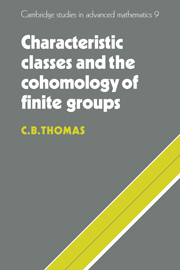Book contents
- Frontmatter
- Contents
- Introduction
- 1 Group cohomology
- 2 Products and change of group
- 3 Relations with subgroups and duality
- 4 Spectral sequences
- 5 Representations and vector bundles
- 6 Bundles over the classifying space for a discrete group
- 7 The symmetric group
- 8 Finite groups with p-rank ≤ 2
- 9 Linear groups over finite fields
- Appendix 1 The Riemann–Roch formula
- Appendix 2 Integral cohomology of non-abelian groups of order p3, p ≥ 3
- Appendix 3 Non-abelian groups of order p4, p ≥ 5
- References
- Index of symbols
- Index
- Frontmatter
- Contents
- Introduction
- 1 Group cohomology
- 2 Products and change of group
- 3 Relations with subgroups and duality
- 4 Spectral sequences
- 5 Representations and vector bundles
- 6 Bundles over the classifying space for a discrete group
- 7 The symmetric group
- 8 Finite groups with p-rank ≤ 2
- 9 Linear groups over finite fields
- Appendix 1 The Riemann–Roch formula
- Appendix 2 Integral cohomology of non-abelian groups of order p3, p ≥ 3
- Appendix 3 Non-abelian groups of order p4, p ≥ 5
- References
- Index of symbols
- Index
Summary
If G is an arbitrary finite group (more generally a finitely presented possibly infinite group) it is an easy exercise in combinatorial topology to construct a finite 2-dimensional simplicial complex with fundamental group isomorphic to G. By attaching simplexes of dimension ≥ 3 in a systematic way it is possible to embed this 2-complex in a larger complex K(G, 1) without changing the fundamental group, but choosing K to have universal covering space homotopy equivalent to a point. One may then define the cohomology groups Hk(G, ℤ) of the discrete group G to be the cohomology groups of the space K. This definition is independent of the topological model chosen, and may indeed be copied algebraically with the coefficients ℤ replaced by some (left) ℤG-module A. It is clear that the graded ring {Hk(G, ℤ), k ≥ 0} is an important invariant of the group, indeed if the homomorphism ϕ: G1 → G2 of finite groups induces an isomorphism (ϕ*: H*(G2, ℤ) → H*(G1, ℤ), then the groups G1 and G2 are isomorphic. However although the literature contains one or two striking applications of group cohomology, for example to the construction of infinite class field towers and to the study of outer automorphisms of p-groups, its systematic use as a tool has been held up by a lack of calculations for specific groups.
- Type
- Chapter
- Information
- Characteristic Classes and the Cohomology of Finite Groups , pp. ix - xiiPublisher: Cambridge University PressPrint publication year: 1987

